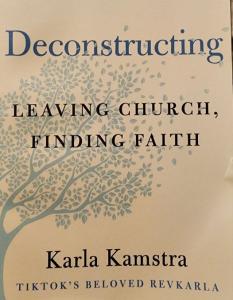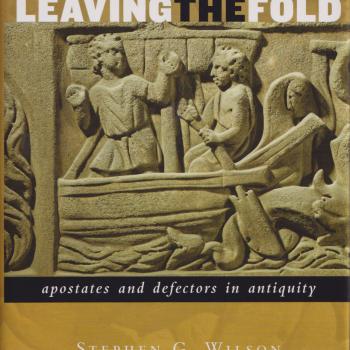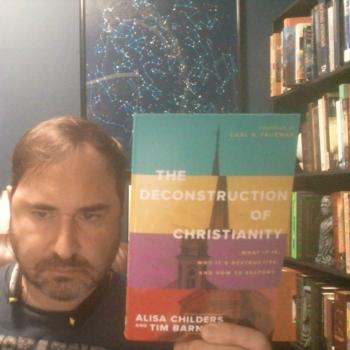
Published in October of this year, Deconstructing: Leaving the Church and Finding Faith is a book which is both an autobiography and a life-coaching guide for people struggling with their Christian beliefs or belonging.
The book was written by and follows the life of Karla Kamstra, a reverend and social media star who has made her mark online by talking about faith, feminism, and the problems with Evangelicalism.
Synopsis
Kamstra grew up in a Kentucky church with broadly fundamentalist views of Biblical inerrancy, discouraging exploration outside of the teachings and practices of the immediate church environment, and, to her great discouragement, the submission of women.
Kamstra says that she was introduced to the church by her grandmother, who loved the church, the Bible, and especially, the person of Jesus. As she sat in church with her grandmother as a child, she decided that she would like to one day become a preacher. However, as she grew, she found that her church discouraged women from taking a ministerial role. She tried serving in other ways, but even in those areas of service, she felt marginalized, disrespected, and underappreciated. One such instance she cites is when a young couple showed up at the church one evening, expressing interest in possibly attending the church. Eager to encourage them, Kamstra began to give them a tour of the church. Unaware that an event was taking place in one of the conference rooms, she opened the door and was very publicly excoriated right in front of the young couple – humiliating her and scaring them away.
Kamstra eventually leaves the church for good, and cites three different historical figures as instrumental in her eventual exit. The first of these is King Henry VIII. This English monarch established the church of England because the Catholic Church refused to authorize a divorce he wanted (because his current wife did not bear him a boy-child to take over the throne). Not receiving the answer he wanted from the Catholic Church, he founded the Anglican Church contingent upon them affirming his divorce.
The story was shocking to Kamstra for several reasons, not least of which was the terrible way in which Victorian culture treated women. Further, however, it made her see the arbitrary nature of Christian religion: that churches can be founded and dismissed on a whim so that the men behind them could use them as tools of manipulation to get their own way.
The second man she cites as instrumental in her leaving the church was the British author C. S. Lewis. In her insular Kentucky church, there were approved Christian authors, and then there were heterodox authors that members of the church were discouraged from reading because their beliefs and ideas were not in lockstep with the teachings of her particular church. Lewis was among these forbidden authors. Kamstra decided to step out of line and pick up Lewis’ magnum opus, Mere Christianity. The title alone struck her as heresy, that anyone would dare to refer to Christianity as “mere,” as if it were unimportant or trivial.
Nevertheless, Kamstra found that she quite liked Lewis’s writing, and decided that perhaps Christian authors outside those approved by her church might be worth further consideration. This led her to pick up books by Bishop John Shelby Spong. Spong is a longstanding critic of the modern church, suggesting that the church ought to be restructured along more Progressive lines, including feminism, social justice, and queer theology to make the church a more open and progressive institution.
The ideas of Spong resonated with Kamstra, not least because it would allow her to enter the role of Reverend that she had always dreamed of doing.
Upon entering seminary, Kamstra eventually did become an ordained Reverend, but considers herself in the category of Spiritual-but-not-religious.
Themes
The most recurring theme within the book is that of feminism. Upon the first mention of God with the pronoun “He,” Kamstra includes a footnote apologizing for using a masculine pronoun, and explaining that she is only doing so out of convention and not because she buys into the gendered category of God as a man. She follows this theme up later in the book by including a chapter on “The Divine Feminine,” in which she speaks of how liberating it is to see the divine as a nurturing, empathetic, life-giving, and overall feminine rather than domineering, bullying, masculine character.
Kamstra includes frequent explanations of terms such as “mansplaining” for her reading audience, and provides a trigger warning before mentioning that someone once referred to her as “anorexic” due to her slender frame. Additionally, the book begins with a trigger warning in which she warns the reader that the book will discuss Religious Trauma, and readers who might be triggered by such discussion ought to reconsider reading the book.
Kamstra also frequently pauses to explain the feminist vocabulary she is using, and provides a helpful Glossary of terms at the back of the book, defining difficult terms like “Microaggression,” and “White Privilege” for the reader.
Kamstra also establishes a mantra for the book from the outset: Demolish, Repair, Restore. By this she means that one ought to rid oneself of previous dogmas and unpleasantness from one’s religious experience, do whatever work is necessary to rehabilitate oneself from these trauma, and then build a new framework from which to proceed. Each chapter ends with a “demolish, repair, restore” section which gives guidance to the reader on how to take the various challenges mentioned in the chapter, break them down, and build back up from the rubble.
Additionally, she provides prayers or spiritual exercises to build one up at intervals through the book.
Audience
Kamstra has an online following in the “deconstruction” community, as indicated on the cover of her book under her name: “TikTok’s beloved RevKarla.” The TikTok profile she mentions has over seven-hundred-thousand followers. This seems to indicate that there is an inbuilt audience for her book to whom she has probably already expressed the various messages and themes included in the book.
Nevertheless, this manuscript reads like a book in search of an audience. In most respects, this is a very personal autobiography, explaining her specific struggles and life circumstances, and then assuming the reader will directly relate to them, offering advice to reconstruct the damages she faced.
It seems, however, that the message of the book is tailored only to those who grew up in a very similar church environment as her and underwent the sorts of personal struggles she faced. Nothing is more indicative of this than the point in the story where she feels as if she is committing a rebellious act by picking up a C.S. Lewis book, about which she states, “I knew that no bona fide, card-carrying Evangelical would be caught with one of his books in their home.”
This shows how incredibly narrow her audience must be, given that Lewis’s Mere Christianity sits at number one on the “Top 100 Christian Books” as measured by the Worldview Institute, with a further two of his books in the top ten, and the rest of his books featured somewhere on the list. Lewis is extremely well-read and well-regarded in Evangelical circles, but according to her, the most well-regarded authors were Rick Warren, Joyce Meyer, Charles Stanley, and Tim LaHaye; all of whom are well-read in a specific subset of American churches without the global reach and acclaim of writers like Lewis (also, only one of these three are featured in the Top 100).
This is no doubt true of the church circles in which she trafficked prior to leaving the church for her current “Spiritual-but-not-religious” status, but under-represents the broader Western church as a whole.
However, if her personal experiences with the church are not more generalizable than they seem, her hefty TikTok following would need to be accounted for in some other way. A brief perusal of her channel demonstrates that her videos center around political themes and more general criticisms of Evangelicalism – both popular subjects for the young, politically active, post-Christian audience of TikTok.
While the author admits that each person’s deconstruction experience is very individual, all of the coaching revolves around her personal experiences and conflicts she faced in her personal life.
So the degree to which this book fulfills its stated purpose of offering wisdom to those undergoing deconstruction will largely depend on how much the reader is able to relate to her particular experiences and views.
The book makes no obvious attempt to expand its reach beyond those who already understand her personal background, views, and experiences, so this book is probably written with her online followers in mind, with them as the target audience.
Deconversion Research
I am a conversion and deconversion researcher, and so all of my reading is done with my research in mind. What this book did for my research is to confirmed what I call the “Modal-Typical Church,” meaning those environments most likely to produce deconverts. Her church hit these markers, which include a church which encourages or enforces isolation of its members away from outside ideas or influences, a ridged literalist approach to scripture, demanding high levels of certainty in one’s beliefs, emphasizing the supernatural world, and high demands to conform one’s behaviors to church standards.
Autobiographies are always helpful insofar as they provide case studies that add further data to the pile I already have.
In this case it seems that deconstruction (meaning a generic questioning of the religious teachings one has received) and deconversion (meaning discarding one’s Christian identity in favor of an Atheist identity) both follow the same model and trajectory, the only significant difference being in how one’s rejection of one’s former Christian identity is expressed after the fact.
The Book
While readable, the book assumes the reader holds views and experiences similar to those of the author, and adopts a familiar more than a persuasive tone. This is not a book written to persuade, but rather to reflect and console. The degree that you would enjoy reading this book will largely depend on how agreeable you find the narrative and themes I have outlined above.














